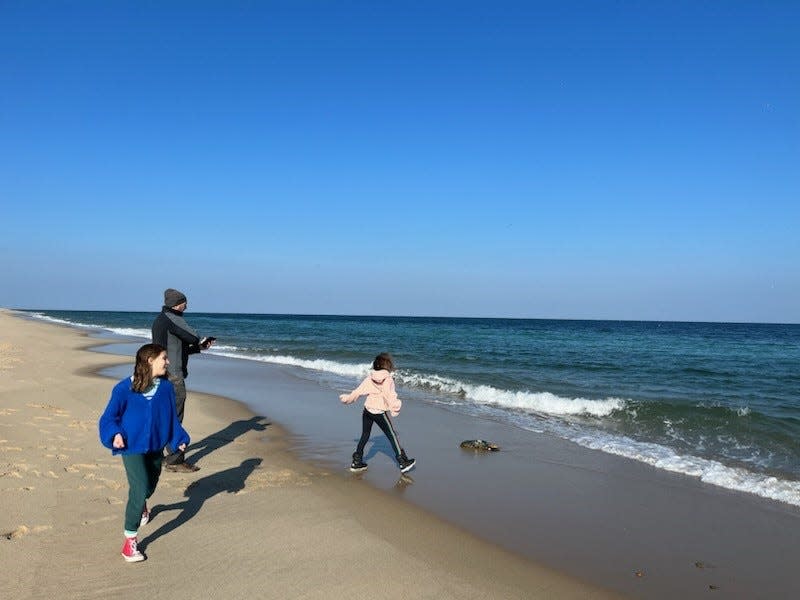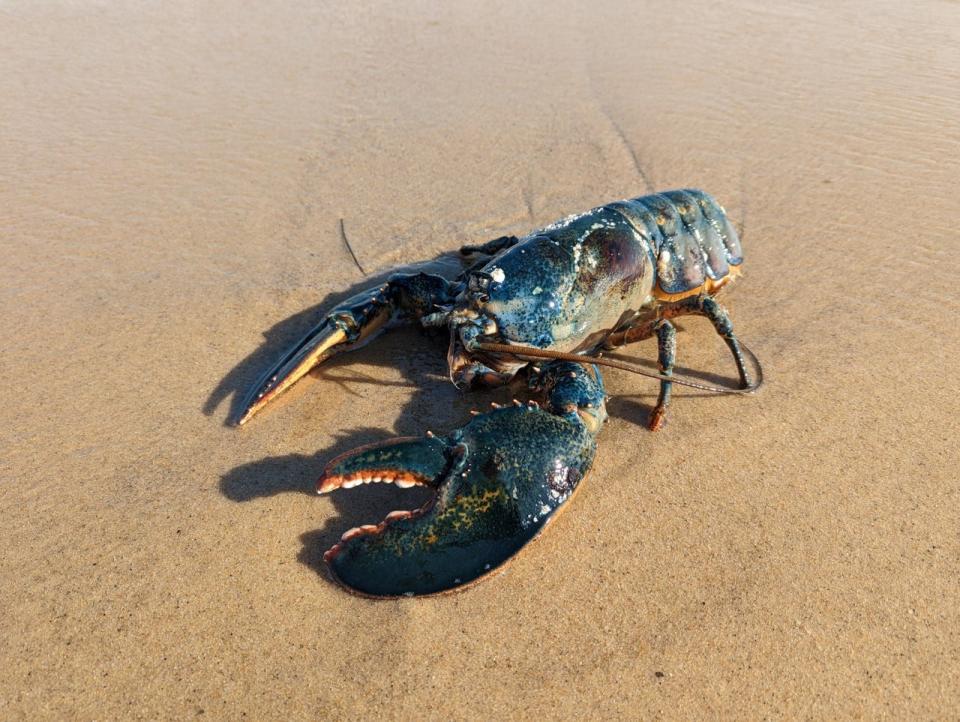Vacationing family finds massive blue lobster on Truro beach
TRURO — While visiting Cape Cod National Seashore recently, 10-year-old Elena Butterbaugh and her 8-year-old sister, Alice, stumbled upon an out-sized crustacean that could have been a washashore from a Dr. Seuss storybook.
Trailing the girls on a Thanksgiving walk along the Pamet area trails and onto the shore just north of Ballston Beach, Eric and Jess Butterbaugh thought they heard their daughters yell out "a monster! a monster!"
"They were actually saying 'a lobster, a lobster!'" said Eric Butterbaugh.

They knew it was unusual enough to find a lobster just randomly hanging out on the strand, in that place between sea and land where the dispersing waves sizzle with foam and the sand is polished to a smooth, fleetingly glassy finish that can reflect the sky. What elevated it to the next level of oddity, worthy of a Seussian tale, was its color.
"It was blue," said Elena, joining her parents and sister on the phone Tuesday from their Pittsburgh, Pennsylvania home, sharing the details of their exciting beach encounter over their Cape Cod holiday vacation.
The youngster clarified that "it wasn't just like a specific blue. There were a few different shades of blue."
More:Crazy colored crustaceans: Rare lobsters wash ashore at Cape Cod markets
"It was mottled a little bit," agreed Jess Butterbaugh, describing some orange accents on the claws, and areas of cobalt blue and darker blue on the lobster.
Alice said at first she thought the outstanding lobster was a dead fish, as it was partially embedded in the sand. "But when I walked up to it I saw it's the magical lobster," she said.
"I thought it was a rock," Elena admitted.
The family visited Cape Cod often, and knew about lobsters and the sea
Although they don't live near the ocean, the family makes frequent trips to Cape Cod and are familiar with the creatures of the sea and shore. They knew their find was out of the ordinary.
"I knew right away that the girls had found a very rare lobster. We've been to the Cape Cod Museum of Natural History a number of times and have seen their blue lobster, so we knew that blue lobsters are rare," said Eric Butterbaugh. "We also knew that the lobster we found was big. However, I didn't realize exactly how big it was until we went back to the museum a few days afterwards and saw their lobsters. The Truro lobster was easily two or three times the size of the lobsters that are at the museum."

He estimates the barnacle-encrusted lobster was about 10 pounds, and "easily around 2 feet long," with claws he described as "massive." He guessed the weight based on the feel of his wife's 10-pound kettlebell. The lobster's tail alone was "well over a foot," and "it was broad, too" — so much so that he wouldn't have been able to get his hands around it and have his fingers touch.
Blue lobsters are very rare, according to the Cape Cod Museum of Natural History in Brewster
Tyan Bassett, the animal care coordinator at the Brewster museum, said blue lobsters are exceedingly rare. Some scientists estimate there's a one in two million chance of finding a blue lobster, while others say the odds are far greater, depending on the degree to which the coloration is owing to diet or genetics.
"There's a couple of things that we've learned about blue lobsters here. One is it might be dietary blue, meaning it's lacking a certain food in its diet, so it turns blueish," she explained. "We've had one of those ourselves at the museum. When it molted, it was brown again."
And then there are the blue lobsters that are genetically blue. "They legitimately lack the pigment to make them be brown," Bassett said.

Lobsters get their more familiar brown coloration from a red pigment called astaxanthin, which reacts to proteins in the layers of the shell — the pigment is the same one that makes shrimp and salmon appear pink. Some proteins in the shell bind the astaxanthin to create a blue tone; others create more red and yellow tones. Together, the layers of color create the overall brown appearance of most lobsters. When the amount of astaxanthin is low, the lobster appears blue overall. This could be the result of a diet that's low in the pigment, or a genetic mutation in which the lobsters create an abundance of a blue pigment called crustacyanin.
It's rare to find a lobster just "walking around on the beach"
Besides the color of the lobster the Butterbaughs found, Bassett said the size of the crustacean, and the manner of its discovery, were also exceptional. She said finding a lobster just "walking around on the beach" is pretty much unheard of, except for tales from the past of lots of beach-walking lobsters she thinks are more likely tall tales.
As for the 10 pound estimate Eric put on the weight of the lobster, she said, "that's huge!"
"The biggest one we have at the museum is about four pounds," Bassett said.
More:Photo gallery: Rare lobsters on Cape Cod
When they discovered the lobster on the beach, the family called the museum to report their find and spoke with Bassett. Eric said they briefly discussed bringing the lobster to the museum, "but I wasn't sure that we could keep the lobster cold enough to safely transport it" and they didn't want to harm it. Plus, he noted, they were at least a mile from the car.
"I soon realized that I didn't want to be the one to put such an incredible creature in a cage, especially since it's probably older than I am," he said. "Tyan gave me some tips to get the lobster back into the water."
How to get a lobster on the beach to go back into the water?
At first they all thought the lobster was dead because it wasn't moving, but as they tried to return it to the water it became more active. Reluctant to pick the lobster up at first because he wasn't sure if it would reach back and latch onto his hands with its claws, Eric tried to use large sticks. When that didn't work, he said, "I got a little more hands on."
"I was hoping that if we got it into the surf a wave would come and take it back out," he said.
But the surf was too calm.
"The waves didn't have enough momentum to pull it in," Elena explained.

"My first few attempts to get it back into the sea were unsuccessful, and the waves kept pushing it back to the beach," Eric said. "Each time it felt the water, it seemed to perk up a bit."
He ended up taking off his shoes, rolling up his pants and wading out as far as he could before giving the lobster a careful toss into the deeper water. The family was amused to see a few seals watching curiously from the waves.
The family spent about 20 minutes in all observing the lobster and attempting to get it back into the ocean. It was long enough for the lobster to earn a name from the girls.
More:White crustacean may help in shell disease research
"We named him Plankton," said Alice — a designation that, when she was told about it, got a chuckle out of Bassett, who commented "that's a very big plankton!"
Although relatively brief, the encounter was also long enough to create a memory of a lifetime for the Butterbaughs, who are accustomed only to finding shells and sea glass on the beach.
"It was a little surreal," said Jess. "I've never seen anything like that, either, so it was an amazing experience."
Eric called it a true adventure.
"It was incredible. A lobster on the beach in and of itself is rare," he said. "But for it to be blue and for it to be as big as it was, Tyan said it was just a wonderful omen. Before I tossed it back in, I made a little wish."
Gain access to premium Cape Cod Times content by subscribing.
This article originally appeared on Cape Cod Times: Blue lobster found on Truro beach by Pennsylvania visitors

